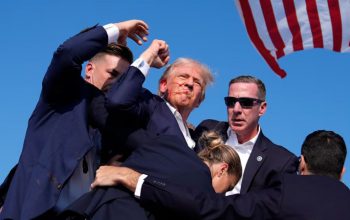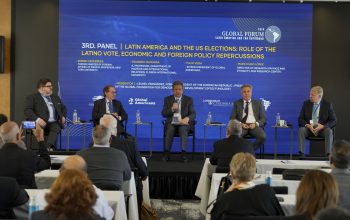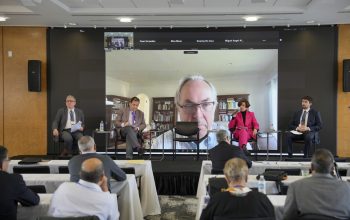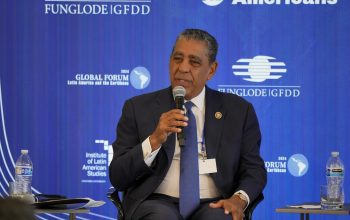news
“The Hillary Clinton–Donald Trump Debate”, an article by Dr. Leonel Fernández
October 7, 2016
The first debate between Democratic Party presidential candidate Hillary Clinton and her Republican Party counterpart Donald Trump drew a TV audience of more than 84 million viewers, the most in history for an event of this type.
It was preceded by outsize expectations. Several TV channels promoted the debate as if it were a boxing match, with the faces of each candidate appearing on the screen with background music that made it seem like a bloody
encounter of fisticuffs.
There were reasons to suspect that in fact that’s would it could be. During the Republican primaries, Trump had weathered a total of 11 debates, peppering his opponents with insults, personal smears, and rude attacks.
It was expected that he’d do the same with Democrat nominee. Many thought he would turn to the same aggressive battle tactics to defeat his opponent for the conquest of the White House. Others
believed he would need to be more sober and focused on transmitting a message to win the support of swing voters.
During the Republican primaries, given the number of aspirants to the presidential nomination, Trump never had to speak for more than 20 or 25 minutes in each of his debate appearances. Nor did he ever face anyone directly, but indistinctly referred himself to all those taking part in the verbal duel.
With Hillary Clinton he would have to be
active for 90 full minutes and directly face a single opponent. Under those conditions he would have to develop arguments, put forward theories, and make proposals requiring political training, public service experience, and good judgment.
He managed to do none of those things: and in that failure laid his misfortune.
The issues of the debate
The most important thing about the debate, in terms of its content, was that it
presented viewers with two visions or ways in which not just American society but the capitalist system should function.
Although the term itself was never used, the debate circled around the phenomenon of globalization. Donald Trump argued that NAFTA was the worst free trade agreement ever written. He proposed that offshored US companies, especially those in Mexico and China, should return to the United States. He also suggested that incentives be created so that in the
future American companies would carry out their productive work within US territory.
This was clearly a radical protectionist position that failed to acknowledge how, within the current interconnected and interdependent global economy, goods are produced through a fragmented system of supply chains.
That was what Hillary pointed out. While free trade agreements could well be improved upon, as she noted with regards to the pending agreement with several
countries in the Pacific, it’s no less true that they are the best way to integrate the global economy, which according to her criteria works to benefit the United States.
To jumpstart the economy and generate jobs, the Republican candidate regressed to old terrain covered long ago during the administration of Ronald Reagan.
His anachronistic thinking proposes that reducing taxes on the rich will stimulate investment and translate into an
energizing of the economy, and in turn the creation of jobs, to the benefit of the most vulnerable sectors of the population.
For Hillary, it’s the exact opposite. She proposes increasing taxes on big businesses and those in privileged positions, with the aim of boosting investment, stimulating economic growth, generating jobs, expanding the middle class, and increasing worker wages.
Donald Trump accused Clinton and the Democrats in general of
wanting to set up a system of regulations on various sectors of the US economy, while saying that a Trump administration would do just the opposite, that is, deregulate.
The Republican candidate insisted that under the program of his opponent – and of the current Obama administration – US debt, which is now some $20 trillion, would further inflate.
But in fact, as Hillary pointed out, it would be a reduction in taxes on the wealthy that
prompted any debt increase, as the state would lack sufficient resources for investment, including in the infrastructure to which Trump made reference.
The candidates’ bickering about these issues did get mired in personal attacks. But in any case, the most important thing is that they threw into relief two conflicting conceptions of how the capitalist system should work in the 21st century.
The history of campaign
debates
The first campaign debate in US history took place in 1858 between Abraham Lincoln and Stephen A. Douglas, who wrangled over a Senate seat. Two years later, in 1860, the same opponents would vie for the United States presidency, although in that campaign no debate took place.
It was a full century later, in 1960, that the historic first debate between presidential candidates was held. It pitted vice president Richard Nixon of the Republican
Party against the Democratic senator for Massachussetts, John F. Kennedy.
It’s said that in that debate Nixon, due to his greater political experience and arguing skills, was deemed the winner over radio. But Kennedy, being more telegenic and better at working the cameras, performed better over television.
Since that moment political science studies have attempted to determine the precise importance or relevance of the debates to electoral
campaigns. What these events seek to do is transmit a message that confirms the vote of a candidate’s supporters, weakens backing for his or her opponent, and wins over undecided voters.
As a confrontation of ideas that’s both time-limited and moderated by communications professionals, it has a pedagogical element, informing voters about the main issues of the campaign, while offering an entertainment spectacle and throwing the personalities of the
candidates into relief.
After the debate between Kennedy and Nixon, president Lyndon Johnson refused to engage in this format during the 1964 elections, and with regard to the electoral contests of 1968 and 1972, in which Nixon reappeared as candidate, he was so emotionally affected by his previous experience that he declined to debate as well.
An encounter of this sort between presidential candidates wouldn’t recur until 1976, when Jimmy
Carter and then-president Gerald Ford entered the political ring.
In 1980, the verbal joust between Carter and Ronald Reagan won the largest viewing audience that had been garnered up to that point in history, reaching some 80 million spectators. From then on, the debates have continued during the campaigns up to this current cycle for the election to be held in November.
Besides expounding on their ideas on the US economy and the workings of the
capitalist system in general, Hillary Clinton and Donald Trump discussed issues related to terrorism, global politics, migration, and race.
In every one of these areas the superiority of Hillary Clinton was notable. The Republican candidate looked lost. He seemed to be lacking ammunition. For the first time, his bravado had failed him. Now he had to face a political veteran who, as she herself indicated, had prepared herself not just for this exchange of ideas but to
become the first woman president of the United States.
There are still two more debates to be held this October before US voters go to the polls to exercise their suffrage and choose the next resident of the White House.
But there is no doubt that what Donald Trump experienced in the first of the debates is what in boxing jargon could well be called a proper and resounding knock-out.
Because that’s definitely what it
was.
Related Link:
http://leonelfernandez.com/articulos/el-debate-entre-hillary-clinton-y-donald-trump/






